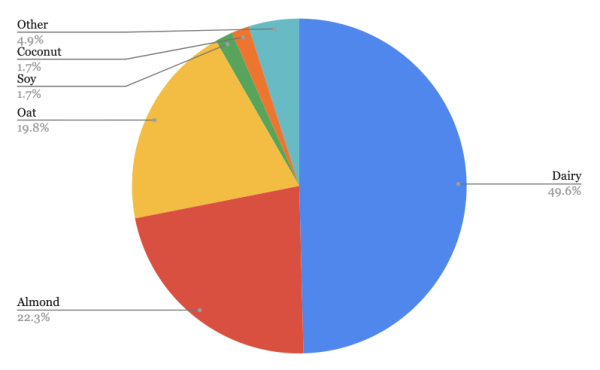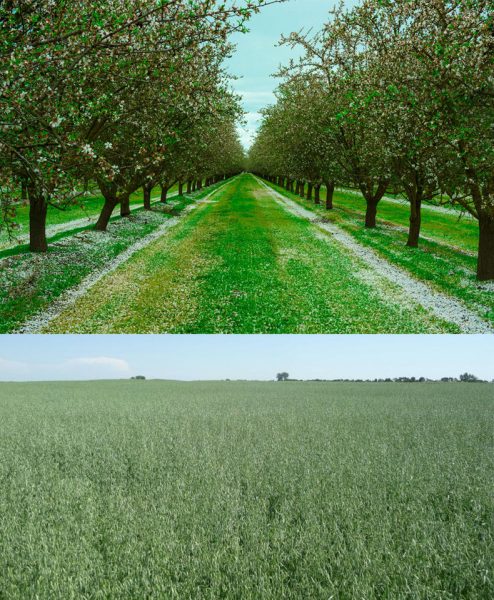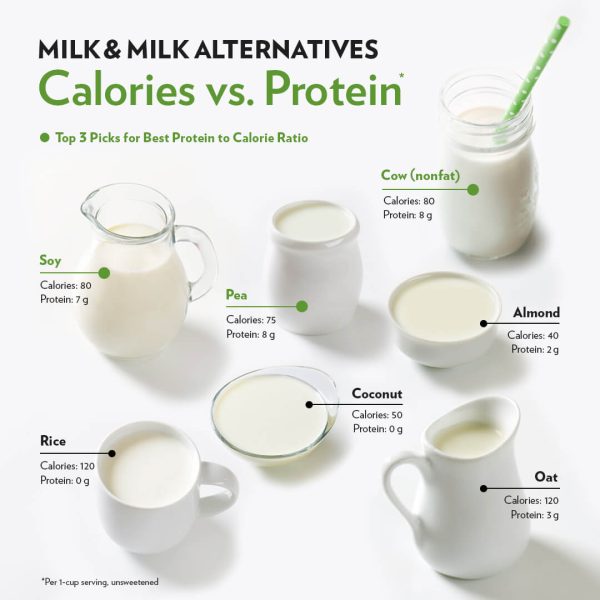In recent years, alternative dairy products such as almond milk and oat milk have become mainstay items on coffee shop menus, grocery store shelves, and in the morning routines of many Americans, including Sacred Heart Greenwich students and educators. When placing an order at the café counter, there are a myriad of factors to consider: flavor, cost, and health pros and cons of different milk types, to name a few. This particular King Street Chronicle report sheds light on the environmental stories of three such products, tracing the paths they took to the coffee cup, from cattle farms to almond orchards.

The popularity of plant-based milks has soared in the past two decades and will continue on this trajectory. Experts project a 127 percent increase in revenue from alternative dairy products from 2014 to 2027, according to unc.edu. In 2023, about half of households purchased plant-based milk, according to gfi.org. The Sacred Heart community mirrors this statistic, with half of Upper School students and faculty reporting a preference for non-dairy milks.
One reason for this transition is growing awareness and concern for environmental sustainability. The dairy industry is infamous for its contributions to climate change through methane, a greenhouse gas produced during cattle digestion. Although responsibly managed pastures can counteract methane emissions, prevailing non-regenerative methods make dairy milk an environmental concern, according to worldwildlife.org. Additionally, raising livestock requires land, water, and feed, depleting resources and infringing upon natural ecosystems, according to americandairy.com.
In the Upper School, the two most common non-dairy choices are almond and oat. Of survey respondents, 22.3 percent cited almond milk as their primary choice, and 19.8 percent cited oat milk. The manufacture of both products involves soaking the nut or grain in water before blending the mixture into a pulp and straining it. Such plant-based alternatives require about 10 percent less land and 50 percent less water than dairy milk, according to uclahealth.org. Yet, the production of almond and oat beverages is not environmentally innocent.

Almond monoculture damages pollinator populations and inhibits biodiversity. In the United States (US), almonds come primarily from Central Valley, California, where large, single-species orchards encompass a region as large as Delaware. In order to pollinate these trees, the industry relies on billions of annually-imported honeybees. However, heavy pesticide exposure and stress can weaken and kill the hives. One growing season, over a third of US honeybees died as a result of this almond-producing system, according to theguardian.com. Such pollinator loss has ripple effects on natural ecosystems as well as American agriculture. Almond production also requires large amounts of water, using 3.2 gallons per almond, although still less than dairy milk, according to bastyr.edu.
Commercial oat production is relatively sustainable, requiring less water. However, grain producers significantly apply pesticides and herbicides such as glyphosates, introducing toxins into waterways and posing health risks. Still, some experts evaluate oat milk as the most sustainable plant-based dairy option, compared to almond, coconut, rice, soy, and other milks, according to theguardian.com.
Despite the dairy industry’s potential for more regenerative methodology, non-dairy alternatives are currently more environmentally sound, with less emissions and land and water use. Food sustainability consultant Mr. Issac Emery voiced support for plant-based products.
“Drink what you want,” Mr. Emery said, according to theguardian.com. “If you’re going with plant milk instead of animal milk, you’ve already addressed most of the environmental problems that your animal milk habit was causing.”

About 75 percent of the Sacred Heart community also noted personal health reasons among their top two considerations when choosing a milk variety. Indeed, cow milk poses dietary issues to those with allergies or sensitivities. About 68 percent of the global population experiences lactose malabsorption, a condition in which dairy products cause indigestion and discomfort, according to nih.gov.
Plant-based or lactose-free milks can alleviate such symptoms. Yet, the nutritional value of different milks varies. Cow milk provides vital nutrients, including calcium, phosphorus, and vitamins that support bone strength and healthy blood pressure, according to myplate.gov. Without added supplements, almond and oat milks lack some of these nutrients. They also contain less protein, as almond milk offers only 1 gram of protein per serving, whereas cow milk generally provides 8 grams per serving, according to uwyoextension.org. Still, non-dairy alternatives offer nutritional pros as well as cons, containing fewer calories, according to webmd.com. These nutritional differences do not necessarily make one type of milk “healthier” or “better” than another, but awareness of the distinct benefits can help consumers make informed choices for their own health, according to usatoday.com.
Mr. Jonathan Gold, Sacred Heart Food Service Director, has worked in the food business for over 25 years. He noted the rise in popularity of plant-based milks in the past 15 years, beginning with soy and rice and eventually branching into more recent arrivals such as almond, oat, cashew, and coconut.
Mr. Gold explained that he tends not to use these non-dairy liquids in his work because the texture and composition react differently to heat and cooking processes. Additionally, as a school food director, he mentioned that he must be mindful that many schools regulate nut-based milks due to student allergies. Mr. Gold spoke about the nutritional benefits and drawbacks of the various dairy alternatives.
“I do feel that every milk product has its advantages and disadvantages,” Mr. Gold said. “Some dairy-free milks have lots of B vitamins, some have loads of potassium, and some are high in vitamin D, but only cow’s milk has it all. The combination of these essential nutrients naturally found in dairy milk not only builds strong bones but also contributes to maintaining a healthy immune system. Cow’s milk is also higher in protein. Plant-based milks, however, give those with medical issues like lactose intolerance an opportunity to eat and drink foods that are similar to their dairy versions, like oat milk chocolate or coconut milk ice cream. There are definitely pros and cons to both dairy and non-dairy milk products.”
Featured Image by Avery Kim ’24





Rick Bria • May 4, 2024 at 10:40 am
Very good article!
Goat milk is my choice. I’m lactose intolerant but I don’t have issues with goat milk. I’ve considered plant based milk but as your article explains, they all have advantages and disadvantages.
Rick Bria